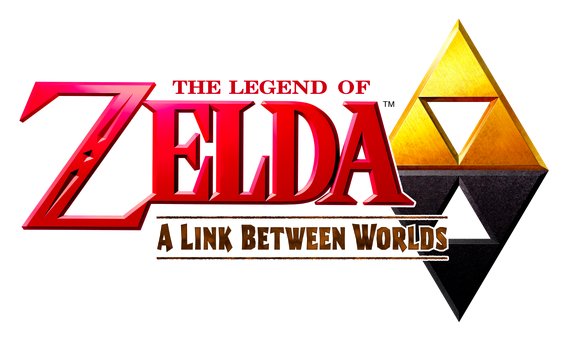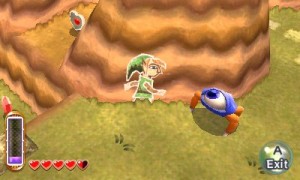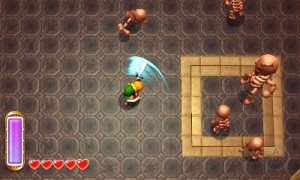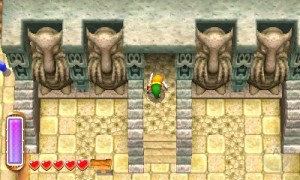[E3 Impressions] The Legend of Zelda: A Link Between Worlds

System: Nintendo 3DS
Release Date: November, 2013
Developer: Nintendo EAD
Publisher: Nintendo
Author: Jack
With the final day of E3 2013 coming to a close and still with a litany of tasks yet to accomplish, I had almost forgotten to swing by the 3DS section in the middle of the massive Nintendo booth to check out one of the biggest releases Nintendo had to offer this year: the much-anticipated direct sequel to one of the most important games in the history of the company, The Legend of Zelda: A Link to the Past. Finally brandished with a spiffy new name (and a recently published preview article to boot), I was very excited to end my E3 experience with a grand finale on top of what was already a solid showing from the Big N.

Upon choosing the ‘Overworld’ option (the other being a ‘Temple’ option) in the demo’s main menu, I was underway, starting things off right at Link’s house, just as if you’d be starting off a round of A Link to the Past. Scanning the map on the bottom screen (indeed, there will be no touch control as there was in Phantom Hourglass and Spirit Tracks), I quickly noticed something pretty interesting– Link’s house was in the exact same spot as Link’s house was on the A Link to the Past map. In addition, a desert area similar to the desert area surrounding the first Sacred Pendant temple in the 1992 title was in the exact same spot on this map as well.
While the two locales and the path between them were the only explorable areas in the demo, upon reaching the desert and noticing the exact same infrastructure as in A Link Between Worlds’ predecessor (that or something very similar), I was and am convinced the two games share the exact same overworld map. The two maps’ relation to their respective Dark Worlds remains to be seen, but given the same surrounding square shape present in A Link Between World’s map, one would assume, at the very least, it’s the same with some minor changes.
I also took a quick glance at the heads-up display on the 3DS’ upper screen and noticed two interesting things: a translucent A button on the bottom right, and a large vertical meter on the bottom left. Pressing A near a wall, I would soon learn, would smoothly transition between normal gameplay and the game’s most ambitious new ability, silhouette wall-adhering (more on that later). Wanting to get a move on after messing around with the new ability, I tried rolling to get to my destination quicker; Link simply stutter-stepped, and kept on a-walkin’. Not believing what I’d just seen, I pressed A again, to no avail. After trying R, L, and every other dang button on the dang console, I’d come to a very big conclusion– rolling, running, or any physical ability allowing Link to travel faster while walking will not be present in A Link Between Worlds. Link will be a one-speed hero in this go-around.

Still in a learning-as-I-go mindset, when I went to shoot an arrow with the bow (pre-set to the X button on the bottom screen), I noticed the previously aforementioned meter went down slightly; before it recovered, I pressed Y to use the hammer (also pre-set on the bottom screen), and noticed it went down further. Later on, once I utilized the silhouette ability, the meter also went down as well. As it turns out, all items and abilities will indeed have infinite quantities, but can’t be used in overabundance within a short period of time, lest the bottom-left meter be depleted before recovering (in a manner akin to an “overheating” bar in certain racing games).
Setting off to the aforementioned desert area on foo, to get a better grasp of the aura of the game, I shut myself off from the rest of the incredibly loud and jam-packed exposition by putting on headphones. A derivative of the familiar Zelda overworld tune played, and while there were separate sections stemming from the classic theme that definitely need time to digest before fully forming an opinion, an impressive iteration of it was overall presented not, unfortunately; the same goes for what I’d hear of the dungeon background music later as well. While the audio left a little to be desired, the visual aspect of A Link Between Worlds, however, was a different story.

Possessing a great deal of vibrant color, A Link Between Worlds feels vastly different than the stoic, classic sprites its predecessor held, yet successfully manages to create a dynamic new reference to its older counterpart without being blasphemous in the slightest. Green green grass is full and bright; red and blue hues used in the switches in the dungeon were highly-concentrated and fun to look at. The new release, as most modern titles do unfortunately when gauged against the games of yesteryear, doesn’t bear the level of fantastical mysticism one can get lost in, but it does attack the player with more than enough concrete (as opposed to imaginative) utility to make a case for itself.
Seemingly intentionally coinciding with the modern visual stylings is the bouncy, just-feels-good-to-play gameplay, which idiosyncratically couldn’t exist ten years ago due to technological bounds. Enemies bounce off Link’s sword with grace, and the silhouette ability not only exhibits an excellent mosaic-y visual mood, but is fully seamless as well when executed. It’s unconsciously pleasing gameplay (think the way Platinum Games’ resume plays, e.g. Vanquish, to a much less extreme level) that hasn’t really been done before in the Zelda canon, and golly is it exciting and new.

Upon vanquishing a few returning foes (guards, green green slimes, etc.) and reaching the desert, I entered into a temple and was greeted with the “Tower of Hera” rehash we’d all seen in the April Nintendo Direct that announced what was then known as A Link to the Past 2. Featuring color swap nodes that shifted blue and red corresponding barriers up and down and hammer-weak Moles that down themselves once struck, it felt right at home with the first iteration while continuing the theme of stylistic progression.
I noticed at this juncture how profound an impact the 3D had on the gameplay after hitting a Mole with a hammer. Instead of staying down as they had before, they come back up swiftly, an action that propels you up one dungeon floor if you stand upon them properly. The 3D effect the 3DS solely offers here really helped differentiate between levels given the camera’s complete bird’s-eye perspective, and on top of that, simultaneously improves the visuals immensely; this is one of the only 3DS games (along with Mutant Mudds) where I genuinely feel the 3D capabilities add an element to the gameplay and aesthetics where 2D capabilities wouldn’t.
Matching the fresher gameplay feel was the temple design, which featured constant fun, sequential actions on top of the standard puzzle solving we’ve been accustomed to over the years; for example, one puzzle had me stand on top of a downed blue blockade, hit a color swap shift node with an arrow (sending blue up and red down), and then right away go into silhouette mode to access a platform across the way that was previously unattainable from the lower level. Another sequence involving moving platforms came up that had Link go into silhouette mode once a platform ran into a wall sticking out of the facade, allowing him to shimmy around the wall-peninsula to keep pace with the platform. While both sequences didn’t necessarily require fast action, it felt implied and fun to do so, and again, added a slight, perpetual platforming feel to the game that we’ve only seen in snippets throughout the series.

Though I was not able to reach the top of the tower before the demo sadly came to an end, I was thoroughly impressed. This is not a Phantom Hourglass-esque rehash of a console game; A Link Between Worlds, while maintaining the same universe as its predecessor, knows it’s its own sovereign, modern person, and thrives because of it. Nintendo EAD has provided a truly fresh and excellent foundation to this latest Zelda offering, breaking the boundaries between assumed handheld and home console iterations with its stylistic progressions and newfangled emphases on temple pacing. While not enough content was present to cement A Link Between Worlds as a can’t-miss, Joe Mauer-esque prospect, given that a proper Zelda overworld is implied and the possibilities a new or re-imagined Dark World could bring, I’m willing to bet the Twins will have a new catcher on their hands this November. And his name will be Link. Or whatever you want to name him, his name doesn’t have to be Link.
Want to participate in more NintendoEverything goodness?
Try our Facebook page!
Or our Twitter page!